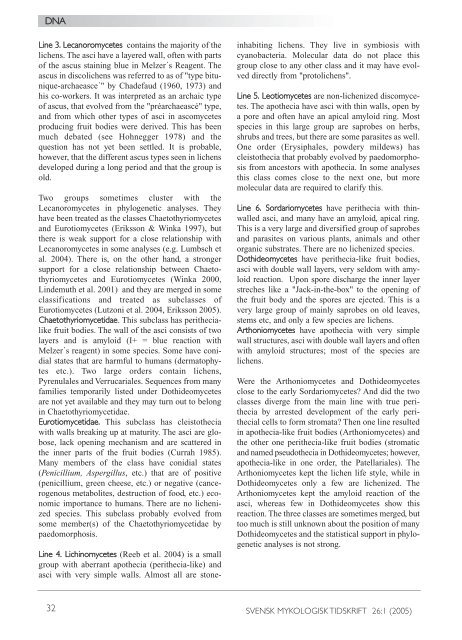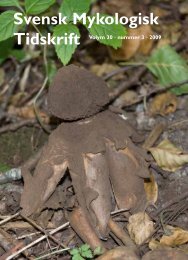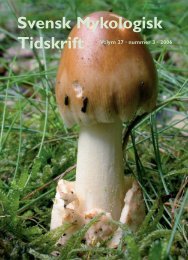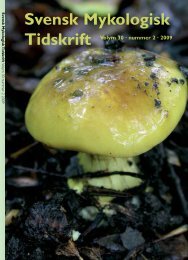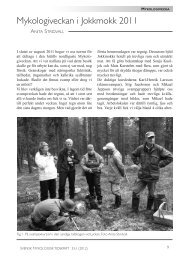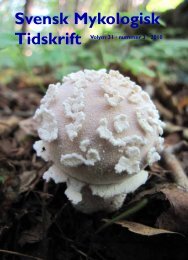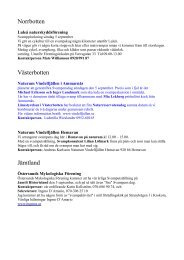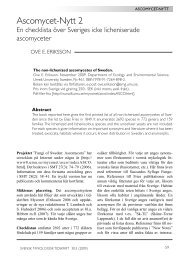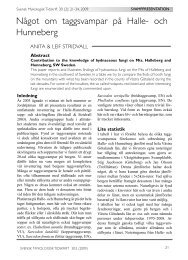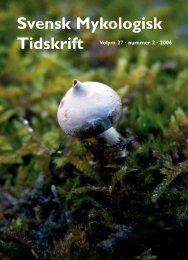SMT 1-2005 - Sveriges Mykologiska Förening
SMT 1-2005 - Sveriges Mykologiska Förening
SMT 1-2005 - Sveriges Mykologiska Förening
You also want an ePaper? Increase the reach of your titles
YUMPU automatically turns print PDFs into web optimized ePapers that Google loves.
DNA<br />
Line 3. Lecanoromycetes contains the majority of the<br />
lichens. The asci have a layered wall, often with parts<br />
of the ascus staining blue in Melzer´s Reagent. The<br />
ascus in discolichens was referred to as of "type bitunique-archaeasce´"<br />
by Chadefaud (1960, 1973) and<br />
his co-workers. It was interpreted as an archaic type<br />
of ascus, that evolved from the "préarchaeascé" type,<br />
and from which other types of asci in ascomycetes<br />
producing fruit bodies were derived. This has been<br />
much debated (see Hohnegger 1978) and the<br />
question has not yet been settled. It is probable,<br />
however, that the different ascus types seen in lichens<br />
developed during a long period and that the group is<br />
old.<br />
Two groups sometimes cluster with the<br />
Lecanoromycetes in phylogenetic analyses. They<br />
have been treated as the classes Chaetothyriomycetes<br />
and Eurotiomycetes (Eriksson & Winka 1997), but<br />
there is weak support for a close relationship with<br />
Lecanoromycetes in some analyses (e.g. Lumbsch et<br />
al. 2004). There is, on the other hand, a stronger<br />
support for a close relationship between Chaetothyriomycetes<br />
and Eurotiomycetes (Winka 2000,<br />
Lindemuth et al. 2001) and they are merged in some<br />
classifications and treated as subclasses of<br />
Eurotiomycetes (Lutzoni et al. 2004, Eriksson <strong>2005</strong>).<br />
Chaetothyriomycetidae. This subclass has perithecialike<br />
fruit bodies. The wall of the asci consists of two<br />
layers and is amyloid (I+ = blue reaction with<br />
Melzer´s reagent) in some species. Some have conidial<br />
states that are harmful to humans (dermatophytes<br />
etc.). Two large orders contain lichens,<br />
Pyrenulales and Verrucariales. Sequences from many<br />
families temporarily listed under Dothideomycetes<br />
are not yet available and they may turn out to belong<br />
in Chaetothyriomycetidae.<br />
Eurotiomycetidae. This subclass has cleistothecia<br />
with walls breaking up at maturity. The asci are globose,<br />
lack opening mechanism and are scattered in<br />
the inner parts of the fruit bodies (Currah 1985).<br />
Many members of the class have conidial states<br />
(Penicillium, Aspergillus, etc.) that are of positive<br />
(penicillium, green cheese, etc.) or negative (cancerogenous<br />
metabolites, destruction of food, etc.) economic<br />
importance to humans. There are no lichenized<br />
species. This subclass probably evolved from<br />
some member(s) of the Chaetothyriomycetidae by<br />
paedomorphosis.<br />
Line 4. Lichinomycetes (Reeb et al. 2004) is a small<br />
group with aberrant apothecia (perithecia-like) and<br />
asci with very simple walls. Almost all are stone-<br />
inhabiting lichens. They live in symbiosis with<br />
cyanobacteria. Molecular data do not place this<br />
group close to any other class and it may have evolved<br />
directly from "protolichens".<br />
Line 5. Leotiomycetes are non-lichenized discomycetes.<br />
The apothecia have asci with thin walls, open by<br />
a pore and often have an apical amyloid ring. Most<br />
species in this large group are saprobes on herbs,<br />
shrubs and trees, but there are some parasites as well.<br />
One order (Erysiphales, powdery mildews) has<br />
cleistothecia that probably evolved by paedomorphosis<br />
from ancestors with apothecia. In some analyses<br />
this class comes close to the next one, but more<br />
molecular data are required to clarify this.<br />
Line 6. Sordariomycetes have perithecia with thinwalled<br />
asci, and many have an amyloid, apical ring.<br />
This is a very large and diversified group of saprobes<br />
and parasites on various plants, animals and other<br />
organic substrates. There are no lichenized species.<br />
Dothideomycetes have perithecia-like fruit bodies,<br />
asci with double wall layers, very seldom with amyloid<br />
reaction. Upon spore discharge the inner layer<br />
streches like a "Jack-in-the-box" to the opening of<br />
the fruit body and the spores are ejected. This is a<br />
very large group of mainly saprobes on old leaves,<br />
stems etc, and only a few species are lichens.<br />
Arthoniomycetes have apothecia with very simple<br />
wall structures, asci with double wall layers and often<br />
with amyloid structures; most of the species are<br />
lichens.<br />
Were the Arthoniomycetes and Dothideomycetes<br />
close to the early Sordariomycetes? And did the two<br />
classes diverge from the main line with true perithecia<br />
by arrested development of the early perithecial<br />
cells to form stromata? Then one line resulted<br />
in apothecia-like fruit bodies (Arthoniomycetes) and<br />
the other one perithecia-like fruit bodies (stromatic<br />
and named pseudothecia in Dothideomycetes; however,<br />
apothecia-like in one order, the Patellariales). The<br />
Arthoniomycetes kept the lichen life style, while in<br />
Dothideomycetes only a few are lichenized. The<br />
Arthoniomycetes kept the amyloid reaction of the<br />
asci, whereas few in Dothideomycetes show this<br />
reaction. The three classes are sometimes merged, but<br />
too much is still unknown about the position of many<br />
Dothideomycetes and the statistical support in phylogenetic<br />
analyses is not strong.<br />
32 SVENSK MYKOLOGISK TIDSKRIFT 26:1 (<strong>2005</strong>)


